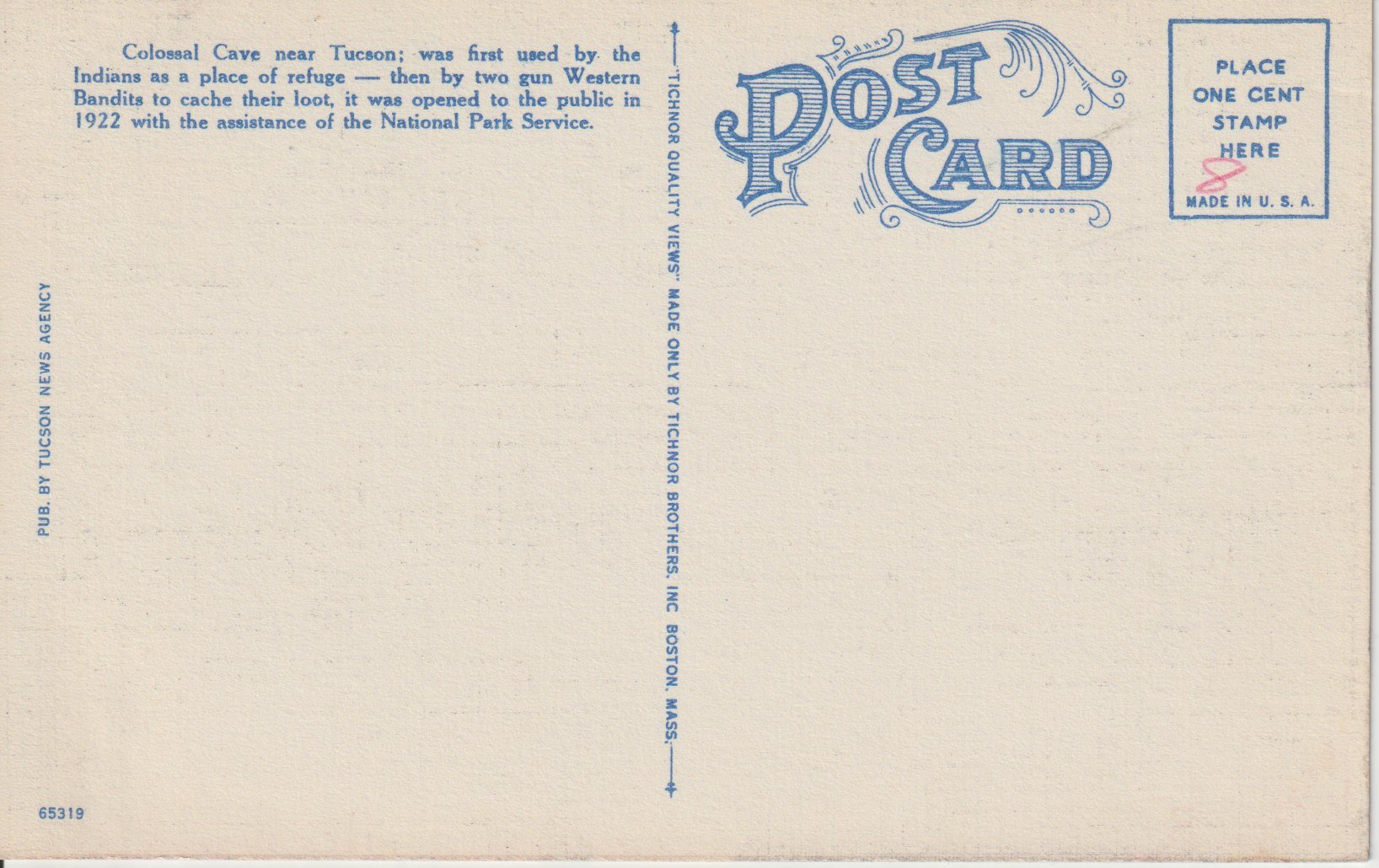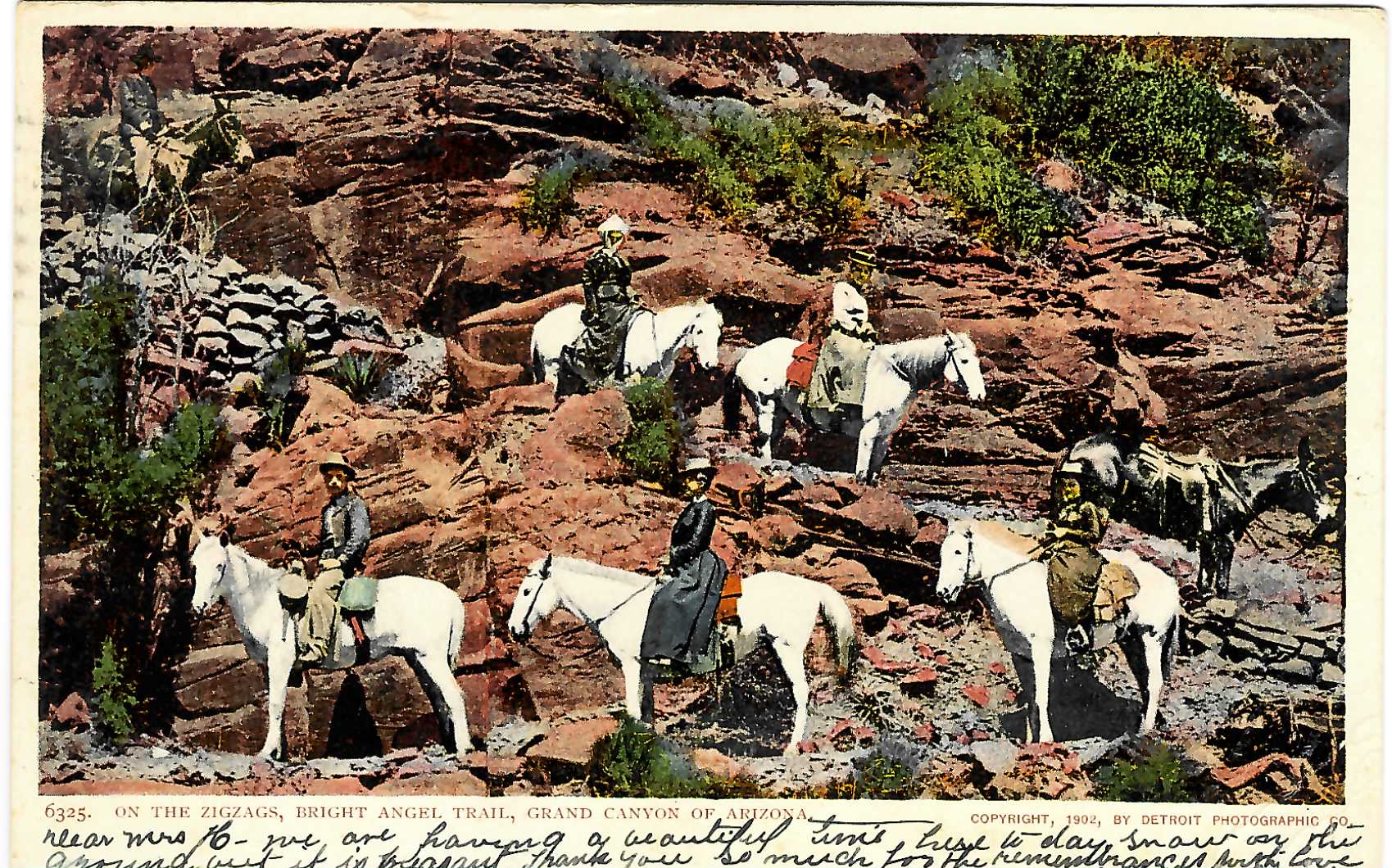
COLOSSAL. BANDITS. CCC.
Colossal Cave near Tucson, Arizona
Our postcard today lived its life, unsent, until now, as I post it.
The caption says, “Colossal Cave near Tucson; was first used by the Indians as a place of refuge – then by two gun Western Bandits to cache their loot, opened to the public in 1922 with the assistance of the National Park Service.
Articles of the day evoke images of Indiana Jones, or Lara Croft Tomb Raider. However, these are real headlines as follows: “Expedition Finds Skeletons Galleries Believed Greater Than Those of Mexican Cave”
The Arizona Daily Star, Tucson Edition, February 18, 1923 says, “Surpassing in beauty one of the most famous examples of its kind, excelling perhaps in vastness the most noted of all, Tucson is possessed within a few miles distance from its limits, of a scenic marvel, the mysteries of which are as yet unsolved and which remains nearly unknown today even in the oldest pioneers of the city.“
Let’s start at the beginning – at least the human beginning. Based on archeological evidence, Hohokam people used the cave as a temporary shelter, beginning in 900AD, up until the “disappearance” of the culture in the 1400’s. I find this very interesting because the cave has a constant temperature around 70 degrees. While I would not love living in a cave, it would have been my solution to air conditioning, had I been around at that time. What relief it must have been on hot summer days. I suppose I would have been in trouble for wandering off and sitting in the cave, as opposed to whatever I should have been doing.
In 1879, a man named Solomon Lick rediscovered or appropriated the cave, recognizing that it had commercial uses. He ran the local hotel, Mountain Springs Hotel, with 6 rooms, springs, and hunting. A cave is a nice attraction in addition to hunting and enjoying the outdoors!
In 1884, said “two gun Western Bandits” arrived. According to legend, 4 men robbed a train, stole $72,000 of gold and currency and hid out in the cave. The sheriff staked out the front of the cave, they escaped from another entrance and were eventually tracked to a saloon in Wilcox, Arizona, where a gunfight ensued. One man lived, went to jail and upon release went back to the cave and then disappeared. Found in the cave were empty mailbags.
I love that these guys were called “two gun Western Bandits”. I did a little searching and found that two gun means that the bandit – or sheriff was adept at using two guns at the same time in said shoot outs.
When this robbery and subsequent siege occurred, the papers carried stories day by day. When the sheriff and posse entered the cave, according the paper, they discovered “cans of lunch tongue, jellies and ground coffee – of the latter there were six or seven unopened cans.” OK – so “lunch tongue”?!?!?!? I have nothing more to say.
Time marches on and in 1923, electric lights were planned for the interior, trains started advertising trips to the cave and one article talks about a convoy of cars driving from Tucson to the cave with 42 tourists.
Our tour guide looks like she is from somewhere around the 1930’s, with her snappy cap and the awesome, sturdy, sensible shoes. Sadly, when the cave when first opened to the public, tourists were encouraged to break off and take stalactites, stalagmites and other cave features.
The Civilian Conservation Corps constructed the buildings that stand today at the entrance to the cave, which remains open to the public.
I hope that Clark Gable, in his many visits to Arizona toured the cave. I wish he’d starred in a movie with the two gun bandits, or as an Indiana Jones exploring the cave and surrounding area. This cave has seen a stream of humanity from the Hohokam, to Apaches, followed by cattlemen (Solomon looking for lost cattle), two gun bandits, the sheriff, tourists who took what they wanted, the CCC and our tour guide. The CCC had a Jack Russell Terrier, named Payday as a mascot and camp dog.
And with that, I end. In my book, this is a great story, with lots of threads to follow.
Off to find the next great Arizona postcard.
Sherry








POST COMMENT